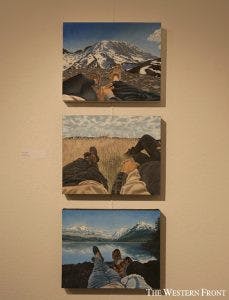A vinculum is the horizontal line often used in math to indicate an infinitely repeating number or pattern. Western art students adopted this idea in their work.
This quarter’s Advanced Studio Art Seminar decided in the last two weeks to name its final gallery show “Vinculum,” studio art senior Miyuki Wong said.
The show opened in the Fine Arts Building B Gallery with a reception on Tuesday, Nov. 28, and featured pieces from oil paintings on wood and canvas, to a digitally created “crystal cafe,” complete with glowing donuts.
The title reflects a theme of pattern and repetition which is present across the works, according to the exhibition’s Facebook page. Senior Jessica Ibsen said it was also just kind of a cool name.
[metaslider id=20215]
Wong said that pattern and repetition have become more prevalent in her art, making fitting into the theme of “Vinculum” a natural process for her. Her piece relates to the show’s theme in that it was created through the regular pattern of her life, she said.
Wong’s project, “Rituals,” featured several framed pieces containing mixed imagery, including a recurring pair of hands and fern leaves accented by gold paint.
“The reason why it’s called ‘Rituals’ is [because] all of the plants I foraged are all from the same path that I go through to school and back every day,” Wong said. “It’s kind of like a ritual in itself to collect all of the things that I put into the pieces.”
Professor Cara Jaye said she tries to give students as much control over the production of the exhibition as possible.
“I try to let them decide how to define the show; how to title, label and package the show; and [to determine] the common threads between the different works,” Jaye said.
The class split into three different teams, each with their own responsibility. An organizational team was in charge of the reception, a publicity team and an installation and setup team responsible for curating and removing works during and after the show, Jaye said.
Students wrote proposals and began working on their projects early in the quarter. A variety of styles across a variety of mediums were represented in the gallery.
“Students come from different disciplines, so it’s really up to them to decide what their work is about, what their work is like and what they want to make,” Jaye said.

Jaye’s teaching style involves giving students room to find their own style.
“I just want to see what [students] want to do and what they like doing and try to get them to become as strong as possible,” Jaye said.
The variety in the class’ style was clearly displayed straight across from the gallery door — a classically styled oil-on-wood painting of a nude model hung immediately adjacent to screenshots of a digital model of a cavernous cafe created by senior Robert Miller.
Miller stood next to the screenshots demonstrating how anyone interested could tour his project using a free website.
He said he has been using the program Blender to create digital models since summer. He is now developing his own video game using the program in his spare time after coming to Western with hopes of creating models for games.
“I wanted to become a 3-D artist, not just make the game. I wanted to do the artwork of the game, the level design and the development areas,” Miller said.
The cave-like “Crystal Cafe,” which Miller created for “Vinculum,” functions much like a video game level, and is only missing an engine program to allow play in the level, he said.
Every piece in “Crystal Cafe” required Miller to create or download a pattern, or “texture,” to paste over the shapes he created in Blender. From the boxes of glowing donuts to the neon crystals growing from the floor to the furniture filling the cafe, patterns were crucial in giving the piece its substance, he said.
For some of the artists taking Art 494 this quarter, incorporating patterns in their pieces meant going out of their comfort zones.
Senior studio art major Karlyn Nourse’s contribution titled “Carolyn” is a three-painting tribute to her grandmother’s art. The paintings incorporated abstract patterns in the background of portraits of her grandmother from various stages in her life.
Nourse said she specializes in portraiture, and the swirling color in the painting’s background was a nod to her grandmother’s abstract-expressionist style, which was a challenge for her to create.
Ibsen’s installation “Nap Spots” is a stack of three oil-on-canvas paintings which looked out on scenes of nature from the perspective of a pair holding hands. The paintings were inspired by hikes with her girlfriend, which often ended in serene places they called “nap spots,” despite the cold, she said.
The couple’s hands were central on the canvas with their legs breaking into the bottom of the frame visible from the waist down as they sat straight-legged.
Ibsen said the consistent composition of the three paintings tied her piece to the patterned theme of the show.
Nourse and Ibsen were among students who had to leave a piece or two out of the exhibition as space was a concern with the work of 16 students filling the gallery.
Jaye, who teaches the seminar, said the class holds a gallery show at the end of each quarter to give students who are close to graduation the chance for one last show at Western.





